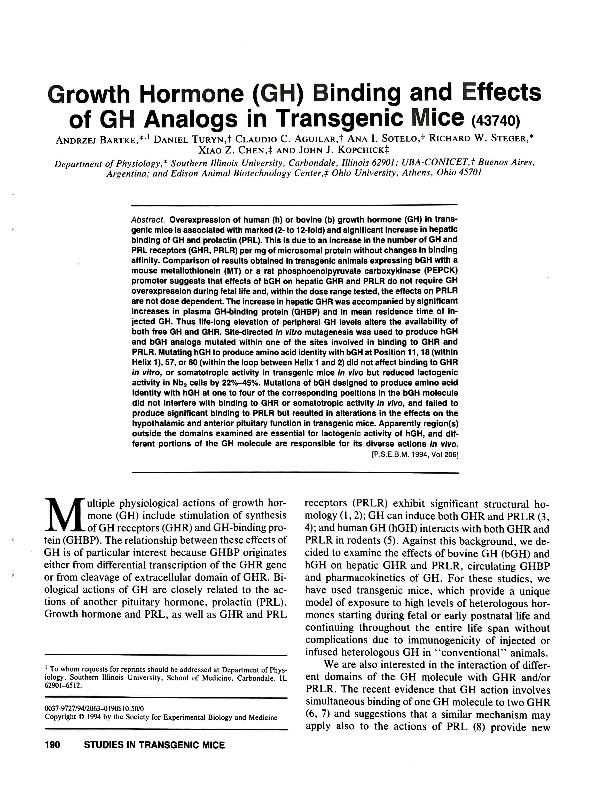Artículo
Growth Hormone (GH) Binding and Effects of GH Analogs in Transgenic Mice
Bartke, Andrzej; Turyn, Daniel ; Aguilar, Claudio; Sotelo, Ana Isabel
; Aguilar, Claudio; Sotelo, Ana Isabel ; Steger, Richard; Chen, Xiao; Kopchick, John
; Steger, Richard; Chen, Xiao; Kopchick, John
 ; Aguilar, Claudio; Sotelo, Ana Isabel
; Aguilar, Claudio; Sotelo, Ana Isabel ; Steger, Richard; Chen, Xiao; Kopchick, John
; Steger, Richard; Chen, Xiao; Kopchick, John
Fecha de publicación:
06/1994
Editorial:
Wiley Blackwell Publishing, Inc
Revista:
Proceedings Of The Society For Experimental Biology And Medicine
ISSN:
0037-9727
Idioma:
Inglés
Tipo de recurso:
Artículo publicado
Clasificación temática:
Resumen
Overexpression of human (h) or bovine (b) growth hormone (GH) in transgenic mice is associated with marked (2- to 12-fold) and significant increase in hepatic binding of GH and prolactin (PRL). This is due to an increase in the number of GH and PRL receptors (GHR, PRLR) per mg of microsomal protein without changes in binding affinity. Comparison of results obtained in transgenic animals expressing bGH with a mouse metallothionein (MT) or a rat phosphoenolpyruvate carboxykinase (PEPCK) promoter suggests that effects of bGH on hepatic GHR and PRLR do not require GH overexpression during fetal life and, within the dose range tested, the effects on PRLR are not dose dependent. The increase in hepatic GHR was accompanied by significant increases in plasma GH-binding protein (GHBP) and in mean residence time of injected GH. Thus life-long elevation of peripheral GH levels alters the availability of both free GH and GHR. Site-directed in vitro mutagenesis was used to produce hGH and bGH analogs mutated within one of the sites involved in binding to GHR and PRLR. Mutating hGH to produce amino acid identity with bGH at Position 11, 18 (within Helix 1), 57, or 60 (within the loop between Helix 1 and 2) did not affect binding to GHR in vitro, or somatotropic activity in transgenic mice in vivo but reduced lactogenic activity in Nb2 cells by 22%-45%. Mutations of bGH designed to produce amino acid identity with hGH at one to four of the corresponding positions in the bGH molecule did not interfere with binding to GHR or somatotropic activity in vivo, and failed to produce significant binding to PRLR but resulted in alterations in the effects on the hypothalamic and anterior pituitary function in transgenic mice. Apparently region(s) outside the domains examined are essential for lactogenic activity of hGH, and different portions of the GH molecule are responsible for its diverse actions in vivo.
Archivos asociados
Licencia
Identificadores
Colecciones
Articulos(IQUIFIB)
Articulos de INST.DE QUIMICA Y FISICO-QUIMICA BIOLOGICAS "PROF. ALEJANDRO C. PALADINI"
Articulos de INST.DE QUIMICA Y FISICO-QUIMICA BIOLOGICAS "PROF. ALEJANDRO C. PALADINI"
Citación
Bartke, Andrzej; Turyn, Daniel; Aguilar, Claudio; Sotelo, Ana Isabel; Steger, Richard; et al.; Growth Hormone (GH) Binding and Effects of GH Analogs in Transgenic Mice; Wiley Blackwell Publishing, Inc; Proceedings Of The Society For Experimental Biology And Medicine; 206; 3; 6-1994; 190-194
Compartir
Altmétricas



